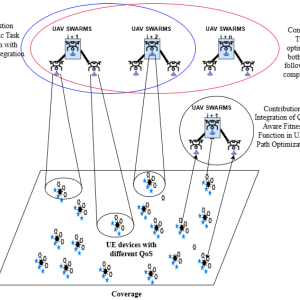The landscape of global defence is undergoing a transformative shift, with advanced technologies at the helm. The European Defence Agency (EDA) recently highlighted the dominant roles that the future of cyber multi-domain operations, new-age technologies, and robotics will play in the upcoming years. This revelation underscores the need for European nations to adopt a forward-thinking approach, positioning themselves at the vanguard of these advancements.

Cyber Multi-Domain Operations: The New Norm
Multi-domain operations encapsulate the convergence of traditional battlefields with cyber and space arenas. This convergence is more than a mere addition to the military portfolio; it represents a paradigm shift in operational planning and execution.
- Integrated Defense Systems: The seamless integration of air, land, sea, space, and cyber domains ensures that a unified defence strategy can be deployed efficiently. As adversaries exploit vulnerabilities across multiple domains, the ability to operate cohesively becomes pivotal.
- Cyber Resilience: Digital warfare is not a distant future possibility, but a prevalent reality. Defence mechanisms need to be resilient against cyber threats, encompassing everything from data breaches to direct attacks on infrastructure. Cyber multi-domain operations are poised to bolster defence systems, ensuring holistic security.
Embracing Cutting-Edge Technologies
The rapid evolution of technology is reshaping defence mechanisms, introducing tools and capabilities that were once considered the realm of science fiction.
- Artificial Intelligence (AI) and Machine Learning (ML): AI and ML are poised to redefine strategy planning, data analysis, and real-time decision-making. With the ability to process vast amounts of data at unprecedented speeds, AI systems can predict potential threats, optimize defence resource allocation, and enhance surveillance operations.
- Quantum Computing: The promise of quantum computers lies in their potential to solve complex problems exponentially faster than traditional systems. In the defence sector, quantum computing can revolutionize encryption methods, satellite navigation, and even missile trajectory calculations.
Robots: The Vanguard of Modern Defence
The role of robotics in modern defence strategies is undeniable. Their potential to execute high-risk operations, gather intelligence, and even deliver precise strikes ensures that they are a cornerstone of the future defence paradigm.
- Unmanned Aerial Vehicles (UAVs): Drones or UAVs are already making a mark in reconnaissance and surveillance missions. As technology advances, their roles are expanding to include combat operations, strategic payload deliveries, and more.
- Ground-Based Robotics: These systems are crucial in performing tasks that may be hazardous for human personnel. Whether it’s defusing explosives, navigating through treacherous terrains, or conducting surveillance in hostile territories, ground-based robots are proving their mettle.
- Underwater Robotics: The marine realm is as crucial as any other domain in defence. Underwater robots or autonomous underwater vehicles (AUVs) are adept at performing deep-sea reconnaissance, monitoring maritime borders, and even undertaking sabotage missions.
Preparing for the Future: A Collaborative Approach
To harness the full potential of these advancements, a collaborative approach is quintessential. The European nations, under the aegis of the EDA, must pool their resources, research, and expertise.
- Research & Development (R&D): Investing in R&D is the linchpin for staying abreast of technological advancements. Fostering innovation hubs, collaborating with academia, and creating public-private partnerships can accelerate the pace of development.
- Training & Skill Development: Embracing new technologies necessitates a skilled workforce. It’s imperative to introduce specialized training programs, simulations, and workshops to prepare the defence personnel for the challenges ahead.
- Infrastructure Modernization: The adoption of advanced technologies mandates a revamp of existing infrastructure. From creating state-of-the-art command centers to upgrading communication networks, infrastructure modernization should be a priority.
Conclusion
The revelations by the European Defence Agency are a clarion call for European nations to embrace the future of defence. As cyber multi-domain operations, advanced technologies, and robotics take center stage, the continent must gear up for a new era of defence strategies. The fusion of traditional methods with cutting-edge innovations holds the promise of a secure, robust, and resilient defence ecosystem for Europe.










